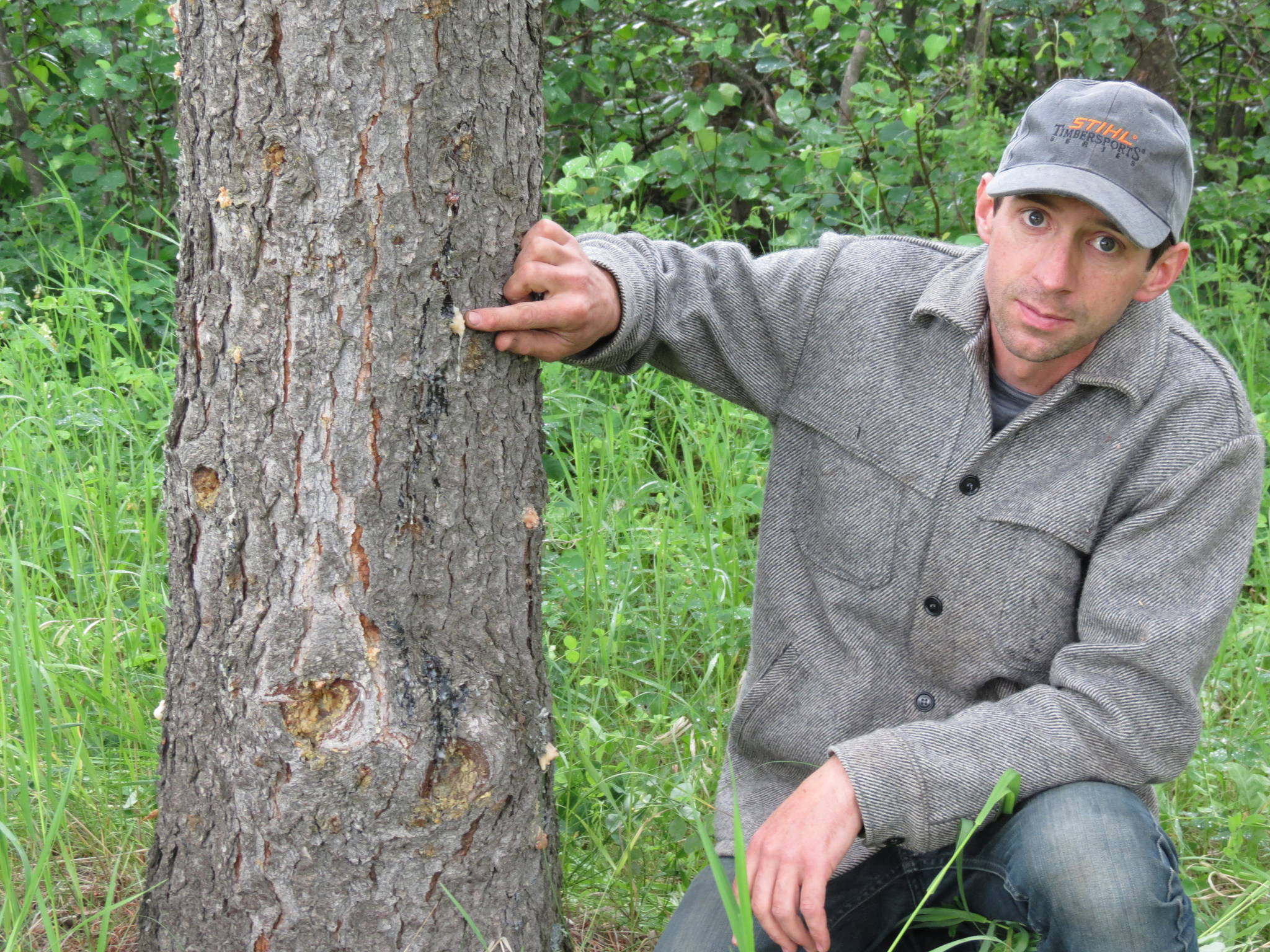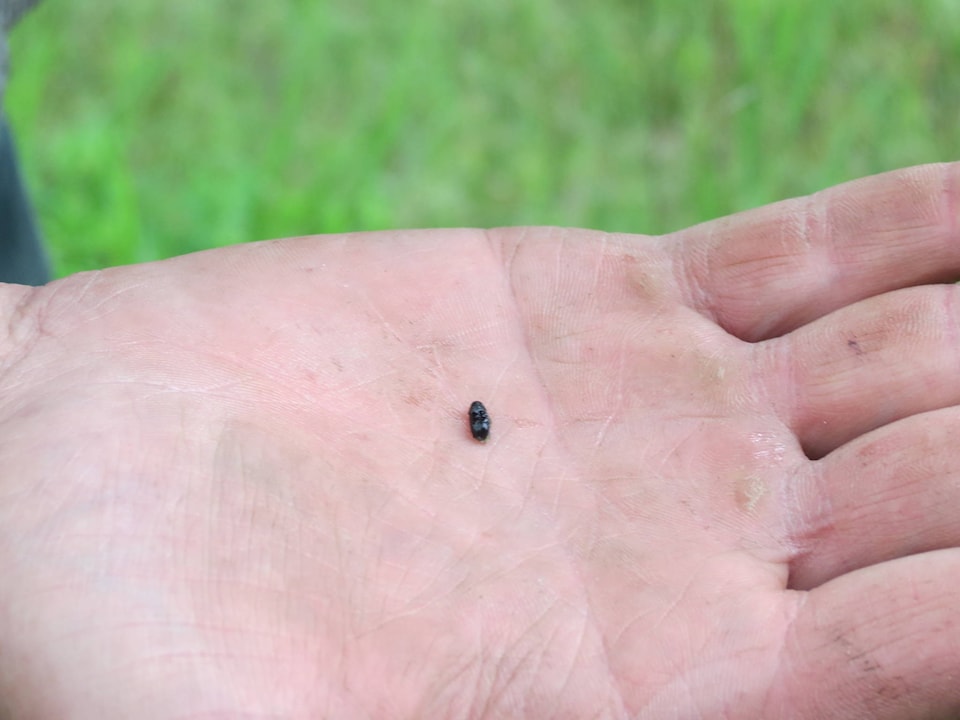Assar Grinde has a special attachment to the pine trees that line the driveway to his mother’s home located north of Rimbey.
The trees have been part of his family history for generations.
Needless to say, when he noticed the trees starting to turn yellow he feared a Mountain Pine Beetle infestation.
Unfortunately, his worst fears have been realized and he has discovered several of the trees to be infected with pine beetles.
“I won’t be planting any more pine trees,” said the young farmer who lives about six miles north of Rimbey.
According to information on Wetaskiwin County’s website mountain pine beetles attack and kill pine trees, usually mature ones aged 80 to 120 years old. All species of pine including Lodgepole, Jack Pine, Scots Pine and Ponderosa Pine are vulnerable.
Last summer the Alder Flats, Winfield, Buck Lake, Pigeon Lake and one location west of Wetaskiwin experienced an inflight of Mountain Pine Beetles, the most destructive insect pest of the lodgepole pine forest, the website states..
Ponoka County agricultural fieldman Justin Babcock said he has recently been made aware of a few instances of pine beetle infestation in the county. He said there had been no reports previously.
“It’s a learning curve,” he said. “We are on alert and will probably hold an information meeting in the fall.”
The Mountain Pine Beetle is a small, black insect about the size of a grain of rice. Beetles fly in search of new trees in July and August. Once a beetle has found a suitable tree, it will live in that tree for the remainder of its life and lay eggs.
The new generation of beetles will not emerge from the tree for at least one year. Trees attacked by Mountain Pine Beetles usually die within one year.
Creamy globs that look like crystallized honey, called pitch tubes and sawdust the base of the tree and in the bark’s crevices are indications that the tree has been attacked by pine beetles.
Wetaskiwin County’s website states that anyone who has infested trees should wrap survey tape around the infected tree. It is recommended that a tree with more than 40 pitch tubes be removed. In the winter months trees can be sold and transported to sawmills and debarked on their site.
Hiring an arborist with a chipper or burning the attacked trees are other options.
Earlier this year Wetaskiwin County sold pheremone pouches to county residents in an attempt to combat the infestation of pine beetles. The pouches contain a synthetically produced substance called verbenone which repels newly arriving beetles, acting as an anti-aggregation. They are now sold out of the pouches.
Verbenone, which should be attached to the north side of the tree between June 15 and July 1, is not very effective when the pressure is high, but is more effective at low to moderate beetle population pressure.
Information contained on line in maps and text called ‘March of the Mountain Pine Beetle’ (https://esrd.maps.arcgis.com/apps/Cascade/index.html?appid=b81dbef8d02344e6bb734087669626db) states that mountain pine beetles have been expanding east into Alberta from British Columbia for several years.
In the past 75 years, Alberta has experienced three MPB outbreaks. The first outbreak occurred from 1939 to 1944 in Banff National Park. This outbreak covered an estimated 4,000 ha. The Federal government actively managed it by using conscientious objectors of world war II to cut and burn 27,000 beetle-infested trees. This was done to control the spread and limit the pine mortality. The outbreak ended when lower than normal fall and winter temperatures exterminated the beetle populations.
The second MPB outbreak began in 1976 in the southern Rockies in the area surrounding Crowsnest Pass. By the time this outbreak ended in 1985, 106,379 beetle-infested pine trees had been removed.
In 1997, the third MPB outbreak was detected simultaneously in Willmore Wilderness Park and in Banff National Park. All the detected trees in Willmore Wilderness Park detected were removed. The main focus being to limit the eastern spread into Saskatchewan and to protect the watersheds of the eastern slopes of Rocky Mountains.In 2005, increasing MPB populations in forested crown land reached an estimated 25,000 trees. The MPB outbreak was declared as an emergency due to the risk to clean water supplies, fire threat to communities, timber resources, and habitat.In 2006 there was a large inflight of beetles over the Rocky mountains and into northern Alberta. Beetles infested thousands of trees in northern Alberta. These trees are not easily detectable until their needles fade from green to yellow to red and die the following year.
In 2009, another massive beetle influx from BC spread beetles far and wide across northern Alberta. Clouds of beetles were reported by pilots and layers of dead beetles were found washed ashore on lakes. Following this event, the estimated number of MPB infested trees in Alberta exceeded three million.In 2011, infested pines with live beetles were detected about 100 kilometres south of the Northwest Territories border. The epidemic spread in the north where no control action was taken, but populations declined in southwest Alberta and in the leading-edge zone. In the same year, infested trees were detected in Cypress Hills Inter-Provincial Park in southeast Alberta.
Surveyors detected 208,459 potential beetle-infested red pine trees in 2013. Beetle populations declined along the eastern and southern outbreak areas, but south of Grande Prairie and toward Whitecourt populations were stable to increasing.Concentric ground surveys are conducted at high priority sites to assess the number of green attack trees for control. Most of these surveys are conducted by contractors. Confirmed sites are controlled by cutting and burning the infested trees to stop the beetles from spreading.
Alberta will continue to battle the MPB in areas where a difference can be made. Since 2005, over 1.48 million beetle infested trees have been surveyed and controlled preventing the death of millions of other pine trees.
For more information on the mountain pine beetle contact Manager of Agricultural Services Justin Babcock at Ponoka County at 403-783-3333 or: 403-506-8832 or email: JustinBabcock@ponokacounty.com
or contact horticulturalist Heather Dickau at hdickau@county10.ca or call 780-352-3321 at Wetaskiwin County.

